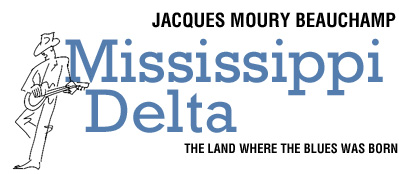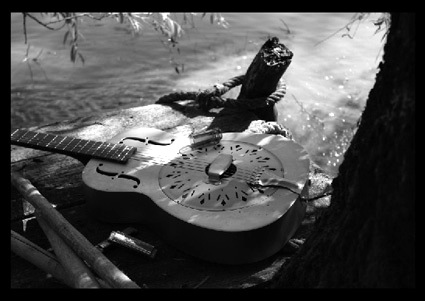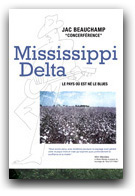
|

Jacques Moury Beauchamp's MISSISSIPPI DELTA series, questions the documentary function of photography, opposing his constructed images to the familiar concept of images as documents captured on site, a concept that he continues to apply elsewhere on a regular basis in his work for the agency PhotoNonStop.
Which images provide the most information and serve the subject that they represent in the closest way?
Contrary to photographs taken where the action actually takes place, the MISSISSIPPI DELTA images have been reconstructed, in the studio in most cases, based on more than 25 years of research on the history of the blues in one of the regions most emblematic of its genesis.
In a reportage, a photographer might not only include elements unrelated to the subject but also omit some essential ones simply because they were not present there at that moment. In his constructed images, Moury Beauchamp's claim is to include (almost down to the last pixel) only elements carefully selected in order to give the most precise description of his subject. Some of these elements have been collected in Mississippi; some, gathered in various other places, are similar to local artifacts. Others have been assembled or even fabricated from scratch to fit these visually narrated stories in the closest way.
Nevertheless, these descriptions do not aim at being historical recreations, but result from the desire to transcribe the highly emotionally charged settings that typify the many facets of the Delta blues, in the true spirit of that music, an intuitive art form if ever there was one.
For this photo series, the artist re-created settings, built installations, and in a few cases assembled elements digitally, excluding no technique that could potentially best serve his project.
The combinations of these processes virtually compressed time and space. They dramatically increased the density of information offered, resulting in a thorough evocation of a century of blues events that left a real mark on the history of the Mississippi Delta.
French born, I always had a strong attraction for visual expression, first as a child, drawing mainly graphic novels, an activity that I would maintain for almost two decades.
I started photography at age twelve and soon discovered the wonders of the darkroom, experimenting early with all sorts of special effects.
I started playing music while a graphic design student at the École des Arts Appliqués in Paris and from then on my work almost always associated visual and musical expressions.
I moved to New York City in 1975, working as a photo reporter for French music magazines. There, I switched to commercial photography, working for advertising, magazine illustration and … record companies.
Soon after my return to Paris in 1984, I opened a large photography studio with two other photographers, a studio that would in 1986 become one of the very first experimental centers for computer assisted imaging.
My fascination for American music, especially the Blues, took me back to the USA and I visited Mississippi for the first time in 1990.
At that time I developed my activities as a fine art photographer and songwriter.
A committed visual artist and musician, I have returned to the “source of the Blues” a few times since and actively contribute to making the origins of this musical form better known through exhibitions, concerts and lectures.
The “MISSISSIPPI DELTA” series was created specifically to premiere at the May Gallery of Webster University in Saint Louis, Missouri. It was inspired by the songs that I sing in my Blues musical performences of the same name. This kind of visual storytelling brought back memories of my early days as a graphic novel artist. It refers directly to the evolution of the music from country to city, from the Delta cotton fields to the streets of Chicago.
|
 |
And with the return to black and white for the first time in more than two decades, this time in the digital darkroom, this series sums up my many fascinations for visual and musical art forms.
|
Gallery
Back to the top of this page
Back to main summary |
copyright © 2011 Jacques Moury Beauchamp
For information on publishing rights, please contact us |
|
|